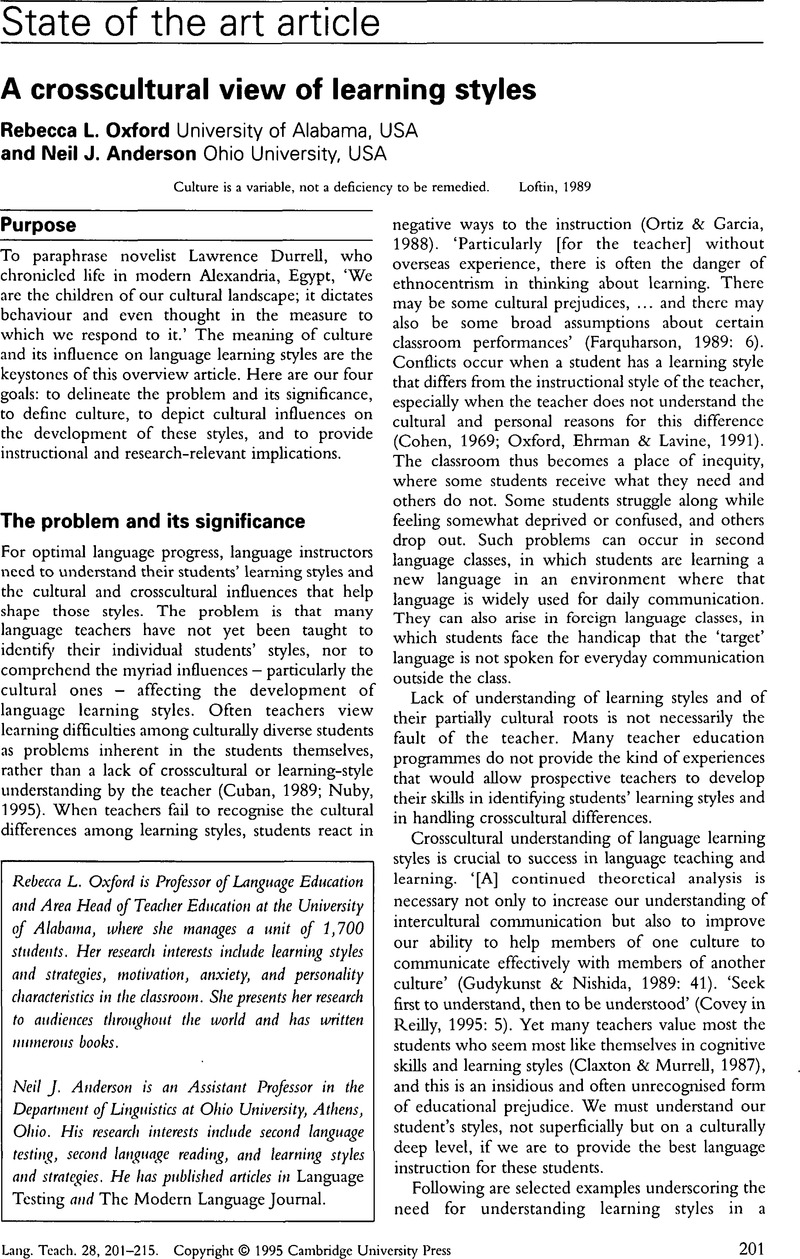Crossref Citations
This article has been cited by the following publications. This list is generated based on data provided by Crossref.
Cortazzi, Martin
and
Jin, Lixian
1996.
English teaching and learning in China.
Language Teaching,
Vol. 29,
Issue. 2,
p.
61.
Oxford, Rebecca L.
1997.
Constructivism: Shape-shifting, substance, and teacher education applications.
Peabody Journal of Education,
Vol. 72,
Issue. 1,
p.
35.
Jones, Sabine
1997.
Encyclopedia of Language and Education.
p.
73.
OXFORD, REBECCA L.
1997.
Cooperative Learning, Collaborative Learning, and Interaction: Three Communicative Strands in the Language Classroom.
The Modern Language Journal,
Vol. 81,
Issue. 4,
p.
443.
Théberge, Mariette
and
LeBlanc, Raymond
1998.
Étude du style d'apprentissage d'étudiants inscrits à un programme de didactique de langues secondes.
The Canadian Modern Language Review,
Vol. 55,
Issue. 2,
p.
191.
Boers, Frank
and
Littlemore, Jeannette
2000.
Cognitive Style Variables in Participants' Explanations of Conceptual Metaphors.
Metaphor and Symbol,
Vol. 15,
Issue. 3,
p.
177.
Landerman, Paul W.
2001.
The House on Castro Street.
Multicultural Perspectives,
Vol. 3,
Issue. 3,
p.
3.
Wintergerst, Ann C
DeCapua, Andrea
and
Itzen, Richard C
2001.
The construct validity of one learning styles instrument.
System,
Vol. 29,
Issue. 3,
p.
385.
Littlewood, William
2001.
Students' attitudes to classroom English learning: a cross-cultural study.
Language Teaching Research,
Vol. 5,
Issue. 1,
p.
3.
Kennedy, Peter
2002.
Learning cultures and learning styles: myth-understandings about adult (Hong Kong) Chinese learners.
International Journal of Lifelong Education,
Vol. 21,
Issue. 5,
p.
430.
Sloan, Tina
Daane, C. J.
and
Giesen, Judy
2002.
Mathematics Anxiety and Learning Styles: What Is the Relationship in Elementary Preservice Teachers?.
School Science and Mathematics,
Vol. 102,
Issue. 2,
p.
84.
Watts, Mike
2003.
The orchestration of learning and teaching methods in science education.
Canadian Journal of Science, Mathematics and Technology Education,
Vol. 3,
Issue. 4,
p.
451.
Cohen, Andrew D.
2003.
The learners side of foreign language learning: Where do styles, strategies, and tasks meet?.
IRAL - International Review of Applied Linguistics in Language Teaching,
Vol. 41,
Issue. 4,
Littlemore, Jeannette
2003.
The communicative effectiveness of different types of communication strategy.
System,
Vol. 31,
Issue. 3,
p.
331.
Hyland, Ken
2003.
Second Language Writing.
Isemonger, Ian
and
Sheppard, Chris
2003.
Learning Styles.
RELC Journal,
Vol. 34,
Issue. 2,
p.
195.
Dörnyei, Zoltán
and
Skehan, Peter
2003.
The Handbook of Second Language Acquisition.
p.
589.
Barmeyer, Christoph I.
2004.
Learning styles and their impact on cross-cultural training: An international comparison in France, Germany and Quebec.
International Journal of Intercultural Relations,
Vol. 28,
Issue. 6,
p.
577.
Yang, Baiyin
Zheng, Wei
and
Li, Mingfei
2006.
Confucian View of Learning and Implications for Developing Human Resources.
Advances in Developing Human Resources,
Vol. 8,
Issue. 3,
p.
346.
Dogancay-Aktuna, Seran
2006.
Expanding the Socio-Cultural Knowledge Base of TESOL Teacher Education.
Language, Culture and Curriculum,
Vol. 19,
Issue. 3,
p.
278.



